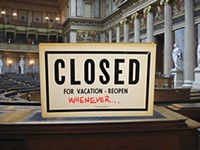The Hightower Report
No escape from cell phones, even in the skies; and, don't give up your biometrics!
By Jim Hightower, Fri., Jan. 14, 2005
CREEPING BIOMETRICS
Am I the only one who thinks it's a teeny bit ironic that a visit to the Statue of Liberty – a world-renowned symbol of America's freedoms – now requires us visitors to surrender a piece of our freedom?
The founders knew from hard experience with the British crown that the protection of individual privacy from the prying eye of authorities was essential for any country striving to be the "Land of the Free." Your personal matters and movements are supposed to be just that – personal, beyond the reach of either government or corporate snoops.
But a creeping (and increasingly creepy) intrusion industry is pushing aggressively into our everyday lives, bolstered by government laws and money. Everything from your travel to your purchases are tracked by massive networks of computers. And now they want not merely data, but little personal pieces of us: our fingerprints, facial features, the iris pattern of our eyes.
To go up into the Statue of Liberty, for example, you now must store your backpacks and such in public lockers. Fine. But rather than the uncomplicated, unobtrusive system of old – put your bag in a locker, drop a coin, take the key, and go – the new system requires that you touch an electronic reader that scans your fingerprint.
This means that your own digit is now the key for getting back your bag ... and the key for what else? Oh, say the operators, trust us – we don't send your print to the authorities. Really? How do we know that? Various government agencies are now authorized to seize our library records or banking information – why would they not feel equally free to grab our biometric data?
Indeed, your digit is going commercial. Piggly Wiggly, Thriftway, and Kroger are among the corporations already beginning to ask that we use our fingerprints, rather than credit cards, to make purchases. It's taking away our privacy, one finger at a time.
CELL-PHONE NATTERING AT 30,000 FEET
Buckle your seat belts, buckaroos! Apparently, the airlines feel they've not done enough to make air travel a stress-filled and downright irritating experience – so now they're pushing a plan to let some cell-phone jerk sit in the seat next to you and yammer nonstop at high volume about nothing for two or three hours as you wing across the country. That's a definition of hell ... and it's a surefire setup for some serious air rage at 30,000 feet.
On practically every flight these days you'll encounter cell-phone maniacs, barking self-importantly into their little chunks of plastic. These callers seem to think that the rest of us will consider them hot shots for calling from a plane. It's pathetic, and the more pathetic they are, the louder they talk, annoying passengers for several rows around. I've seen passengers come close to blows with those pretentious prattlers.
The saving grace has been that the noise ceases once the plane takes off, for cell phones can interfere with the pilot's communications and must be shut off during flight. But the airlines are now seeking regulatory approval for new technology that will let the noisy ones natter into their cell phones clear across the country. "Bob, this is Jack. I'm on the plane to Portland, so this is a good time to go over our third-quarter sales figures." "Beatrice? Hi, it's Nancy. I'm in the air, can you believe it? Have I told you about my bladder condition? What ... you can't hear me? OK, I'll speak louder."
It's going to get ugly up there if this thing goes through. Yet the airlines see it as a moneymaker, so the Bushites are pushing to OK the change, freeing the airlines to make a buck on air rage.
I could be one of those ragers! A few hours of flight time is one of the last sanctuaries of cell-phone silence in our harried world. Must we fill it with infuriating noise-makers just because it's technologically possible? To oppose this intrusion, contact the FCC's Public Comments page at www.fcc.gov.
Got something to say on the subject? Send a letter to the editor.








